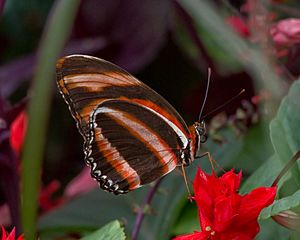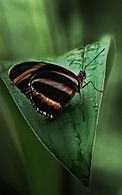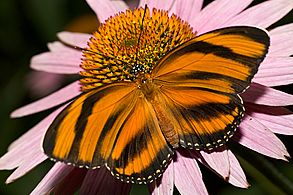Banded orange heliconian facts for kids
Quick facts for kids Banded orange heliconian |
|
|---|---|
| male, dorsal view Panama |
|
 |
|
| female, ventral view | |
| Scientific classification |
The banded orange heliconian (scientific name: Dryadula phaetusa) is a beautiful butterfly. It's also known as the banded orange or orange tiger. This butterfly is the only species in its group, called Dryadula.
You can find these butterflies in warm places. They live all the way from Brazil up to central Mexico. Sometimes, in the summer, they even fly as far north as central Florida in the United States!
Contents
What Does It Look Like?
The banded orange heliconian is a medium-sized butterfly. Its wings can spread out about 86 to 89 millimeters wide. That's about the length of a credit card!
- Males: Male butterflies are a bright, vibrant orange. They have thick, clear black stripes on their wings.
- Females: Female butterflies are a bit different. Their orange color is usually not as bright. Their black stripes are also a bit fuzzier or less defined.
Where Does It Live and What Does It Eat?
These butterflies love warm, tropical areas. You'll often find them in lowland fields and valleys.
- Adult Butterflies: Adult banded orange heliconians mainly drink nectar from flowers. Nectar is a sweet liquid that gives them energy. They also like to sip on bird droppings. This might sound strange, but bird droppings can have important nutrients for them!
- Caterpillars: Before they become butterflies, they are caterpillars. These caterpillars eat leaves from certain plants. Their favorite food is a type of plant called a passion vine, like Passiflora tetrastylis.
Cool Facts: Staying Safe!
The banded orange heliconian has a special way to protect itself. It tastes bad to birds! This means birds usually won't try to eat them.
This butterfly is part of something called a "Müllerian mimicry complex." Imagine a group of different butterflies that all taste bad. They also all look similar, often with orange and black colors. Because they all look alike and taste bad, birds learn to avoid them. It's like a warning sign that says, "Don't eat me!" This helps all the butterflies in the group stay safe from predators.
Special Habits: Mud-Puddling
Before it's time for them to mate, male banded orange heliconians do something interesting. They gather together in large groups, sometimes hundreds of them! They look for patches of moist soil that have mineral salts. This behavior is called "mud-puddling."
Why do they do this? They drink the salty water from the soil. These salts are very important for their health and for successful mating. If they can't find salty soil, they might even visit animals. They drink salty liquids from the animals' skin or noses! It's a clever way for them to get the minerals they need.
See also
 In Spanish: Tigre de la granadilla para niños
In Spanish: Tigre de la granadilla para niños




